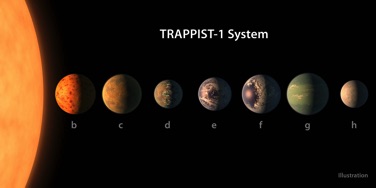The star hosting the new exoplanets is about 4.25 degrees to the east of the star Hydor (Lambda Aqr) in the constellation of Aquarius. The pre-discovery name of the host star was 2MASS J23062928-0502285, as catalogued in the Two Micron All-Sky Survey (or 2MASS). With an apparent visual magnitude of +18.8, it’s far too dim to observe with a backyard telescope. The star’s new designation, TRAPPIST-1, denotes the first system discovered by the TRAPPIST telescope.
Exoplanets are usually named in order of discovery, by adding a lowercase letter, starting with “b”, to the star’s designation. So the new planets are designated as TRAPPIST-1b through TRAPPIST1-1h. The ground-based telescopes initially detected two planets (b and c), plus a possible third one, designated d. The Spitzer Space Telescope confirmed b and c, but the signal for “d” was revealed to be a combination of three planets (e, f, and g). In the process, two new planets, designated d and h were discovered. The decision was made to order the planets by distance from the star.
TRAPPIST-1 System Travel Time
How long would it take to travel from Earth to the 7 potentially Earth-like worlds of the TRAPPIST-1 System? We know that the TRAPPIST-1 system is 39 light-years away from Earth. That means that if we could travel at the speed of light, it would take 39 years to get there. According to Einstein’s theory of general relativity, nothing can travel faster than the speed of light. We currently have no spacecraft that can travel at the speed of light or anywhere close to it.
To calculate the travel time to the TRAPPIST system, you take the distance to TRAPPIST-1 (39 light-years) and divide it by the distance your spacecraft covers in one year. Ensure that the number you are dividing has the same units as the number you are dividing by.
TRAPPIST-1 Distance = 39 light-years = 229 trillion miles = 369 trillion kilometers
Travel Time = Distance to TRAPPIST-1 / distance spacecraft travels in 1 year
or:
Travel Time (in miles) = 229,000,000,000,000 miles / (vehicle speed in mph x 24 (hours) x 365 (days))
Travel Time (in kilometers) = 365,000,000,000,000 km / (vehicle speed in km/h x 24 (hours) x 365 (days))
| Spacecraft | Speed | Info |
| Car | 60 mph (100 km/h) | Safe highway speed. |
| Spaceshuttle | 17,500 mph (28,160 km/h) | Capable of carrying humans. |
| New Horizons Spacecraft | 32,000 mph (52,000 km/h) | Fastest spacecraft ever launched. |
| Juno Spacecraft | 165,000 mph (265,000 km/h) | Fastest ever speed achieved by a spacecraft. |
Use the table above to calculate how long it would take to travel to TRAPPIST-1 with today's transportation technology.
- How many years would it take to travel by car to TRAPPIST-1? It would take your family car about 436 million years to travel the 39 light-years to TRAPPIST-1.
- How many years would it take in the Spaceshuttle to travel to TRAPPIST-1? It would take the New Horizons spacecraft about 1.5 million years to travel the 39 light-years to TRAPPIST-1.
- How many years would it take in the New Horizons spacecraft to travel to TRAPPIST-1? It would take the New Horizons spacecraft about 817,000 years to travel the 39 light-years to TRAPPIST-1.
- How many years would it take in the Juno spacecraft to travel to TRAPPIST-1? It would take the New Horizons spacecraft about 159,000 years to travel the 39 light-years to TRAPPIST-1.
- With today's technology, do you think it's practical to travel to TRAPPIST-1? It is not practical to travel to TRAPPIST-1 with todays current technology because it would take too long to get there.
